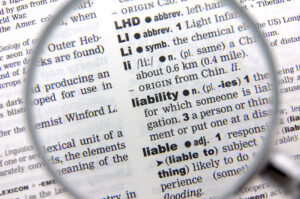
“Strict liability” is a legal theory that allows you to prove a personal injury claim and collect compensation regardless of the defendant’s mental state.
In fact, the defendant may have acted with utmost care yet is still liable for someone else’s damages.
Personal Injury Liability and Mental State

Typically, liability for personal injury compensation depends on the defendant’s mental state at the time of the commission of the act that led to the injury. Following is a description of several of these mental states.
Negligence
Negligence is a legal term that means something like “carelessness.”
To win a negligence claim against a defendant, you must usually prove the following four elements:
- The defendant owed you a duty of care. This could be the ordinary duty of care that every competent adult owes to everyone else. Alternatively, it could be the professional duty of care that a doctor owes their patient.
- The defendant breached their duty of care to you. A driver failed to stop at an intersection as you were crossing it, for example.
- You suffered a personal injury, such as a concussion.
- The defendant’s breach of duty was the foreseeable cause of your injury.
There are other ways to prove negligence under certain circumstances. For example, negligence per se requires you to prove that the defendant violated a safety regulation.
Intentional Torts
An intentional tort is when the at-fault party acts intentionally. In a fit of jealousy, for example, someone might have hit you over the head with a blunt object. This act would probably constitute the intentional tort of battery.
Vicarious Liability
Under a vicarious liability principle, one party is responsible for someone else’s misconduct. The most common situation occurs when an employer bears liability for their employee’s actions.
For example, a restaurant might be liable for the failure of one of its employees to wash their hands before handling food (thereby sickening a customer). Vicarious liability does not apply unless the employee was acting in the scope of their employment at the time of the misconduct.
How Does Strict Liability Differ?
Strict liability differs from negligence, intentional torts, and vicarious liability in the sense that under the other three theories of liability, you can point to a “guilty mind”—a reckless driver, a violent lover, or a careless employee. With strict liability, however, you can’t necessarily point to a specific “guilty mind.”
Types of Personal Injury Claims Where Strict Liability Might Apply
Below are several examples of claims that frequently trigger strict liability.
Dog Bites
You can file a lawsuit over a dog bite in any state. Some states apply a “one-bite” rule that allows the dog owner to escape liability if the dog has never before shown any aggressive tendencies. Other states will hold a dog owner strictly liable even if the dog has never acted aggressively before.
Ownership of Wild Animals
If you own a wild animal (a chimpanzee or an alligator, for example), you are strictly liable if the animal hurts someone. You can bear liability even if your ownership of the animal was legal under local law.
Abnormally Dangerous Activities
Some activities carry an inherent danger. There is no way to make them safe, no matter how many security precautions you take. Yet some of these activities are necessary.
An example is blasting in construction (such as blasting tunnels through mountains). Companies that engage in this behavior can bear strict liability for any injuries that occur. In many cases, government contractors offer them indemnity.
Product Liability
A product liability claim arises when someone suffers an injury due to a product defect. The victim can seek liability even if they did not own the product.
Several forms of product liability exist, one of which is strict product liability. To win a strict product liability claim, you must prove that the product contained a defect that rendered it unreasonably dangerous.
The law recognizes three types of defects:
- Design defects: The product is unreasonably dangerous even when it works exactly as it was designed to work.
- Manufacturing defects: The manufacturing of the product differed from its design in a manner that rendered it defective and unreasonably dangerous.
- Warning defects: An example would be pharmaceutical packaging that was defective because it failed to warn – such as “Should not be taken by pregnant women.”
You can sue any party within the product’s chain of distribution. A contemporary example is the Valsartan lawsuits against Walgreens. These lawsuits are based on a manufacturing defect. Since Walgreens is not a pharmaceutical manufacturer, its misconduct could not have caused a manufacturing defect. Nevertheless, it can still bear liability.
Contact a Seasoned Personal Injury Attorney to Help You Pursue a Strict Liability Claim
It might sound easy to win a personal injury claim based on strict liability. After all, you don’t even have to prove fault to win. Winning such a claim, however, can be deceptively difficult.
If you believe you might have a strict liability case, contact an experienced personal injury lawyer from the lawyers at Runion Personal Injury Lawyers for a free consultation. You can reach us at (602) 600-9000.

